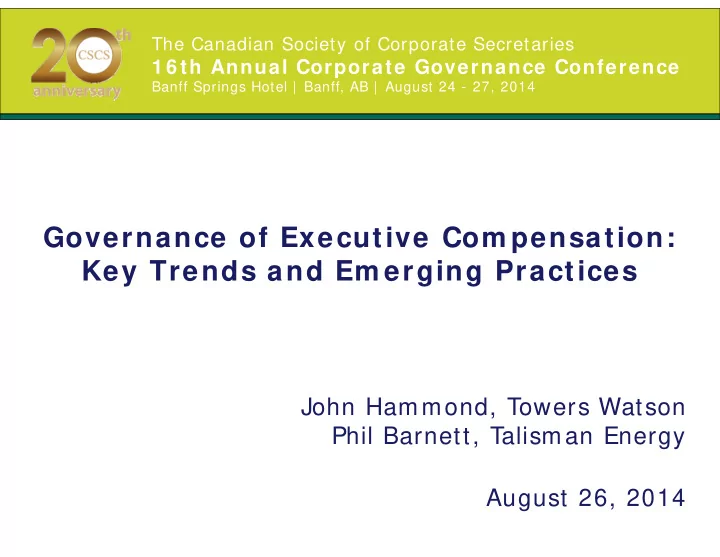

The Canadian Society of Corporate Secretaries 1 6 th Annual Corporate Governance Conference Banff Springs Hotel | Banff, AB | August 24 - 27, 2014 Governance of Executive Com pensation: Key Trends and Em erging Practices John Hammond, Towers Watson Phil Barnett, Talisman Energy August 26, 2014
I n this Session • Highlight evolving executive pay governance “hot topics”: 1. Shareholder engagement 2. Other executive compensation (EC) governance tools 3. Management / HR Committee (HRC) interaction 4. Pay for performance 5. Effective incentive plan designs • For each topic we will use the following framework: Current Trends Talism an Experience • Canadian market practices • Recent experiences, & trends (proxies & surveys) considerations, decisions and lessons learned Evolving Practice Talism an Considering • Consulting insights • Client feedback • What’s next?
1 . Shareholder Engagem ent Current Trends Talism an Experience • Voluntary Say on Pay; • Say on Pay experience 140+ companies in Canada • Changes to executive • Monitoring proxy advisors’ compensation programs voting guidelines • Increased focus on EC • Comprehensive proxy disclosure circular EC disclosure • Direct shareholder engagement by Board Evolving Practice • Direct engagement with • Use of proxy solicitors ISS, Glass Lewis, investor (e.g., Kingsdale) activists and Kingsdale • Meetings with principal Talism an Considering investors on EC topics • Articulating key elements • How proactive do we of EC programs & rationale want to be?
2 . Other EC Governance Tools Current Trends Talism an Experience • Voluntary Clawback Policy; • Executive DSU plan more than 70% of TSX 60 • Clawback Policy • Higher levels of minimum • Increased SOG share ownership • Decreased CEO severance • Voluntary deferral of STIP • Pay-for-performance (P4P) payments in DSUs disclosure (realizable pay) • Peer group update Evolving Practice • Re-focused STIP metrics • Ongoing alignment with • Relative TSR in LTIP shareholder interests, i.e., share retention ratios, Talism an Considering post-departure share ownership, “career shares” • Post-departure holdings • P4P, “cost of EC” and CEO • LTIP vesting on CIC pay ratio analyses
3 . Managem ent / HRC I nteraction Current Trends Talism an Experience • Structure and processes • Approved work plan for HRC annual calendar • More HRC engagement on • Clear responsibilities and P4P and governance approval authorities (e.g., • Two consultant model two consultant model) – Autonomy / • CHRO dotted-line confidentiality of HRC accountability to HRC Chair vs. duplication of work – Comms. more complex Evolving Practice • HRC mandate beyond • HRC mandate beyond compensation traditional EC topics • Greater time and attention Talism an Considering on EC governance and P4P • How to better manage • Interaction / overlap with two consultant model other Committees
4 . Pay for Perform ance Current Trends Talism an Experience • Ensuring incentive plans • Re-set of previous PSUs motivate desired outcomes • “Audit” of P4P in 2013 • Ensuring appropriate – Re-focused STIP weight on “pay-at-risk” metrics and added • Preparing for ISS and relative TSR metric to Glass Lewis assessments PSUs (50% weighting) • Judgment vs. discretion Evolving Practice • ISS and Glass Lewis • Reviewing “realized” and • Review of realizable pay “realizable” pay vs. target vs. performance • Assessing “performance” Talism an Considering through multiple lenses • Stress testing pay • Future performance outcomes and overall cost metrics for PSUs
5 . Effective I ncentive Plan Designs Current Trends Talism an Experience • Structured STIP / LTIP • Designs to fit Company design with tools for HRC strategy judgment / discretion • STIP: focus on • Less weight on options quantitative metrics (retain discretion for HRC) • Rigorous metric selection and target setting • LTIP: 100% PSUs (50% relative TSR, 50% Evolving Practice business metrics) • Financial / operating metrics • P4P and impact on beyond TSR in LTIP behaviour and retention • Differentiating LTIP grants Talism an Considering for corp. / individual perf. • Reviewing value for spend • Linkage of PSU metrics to business strategy • Customizing pay programs; “best fit over best practice”
Recommend
More recommend